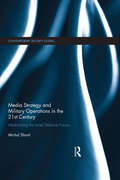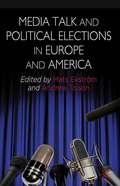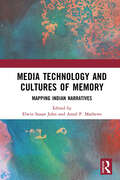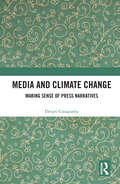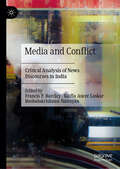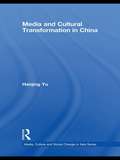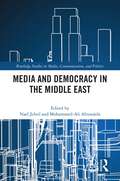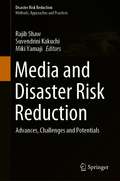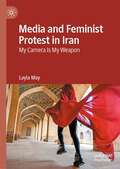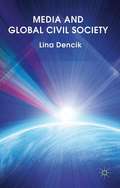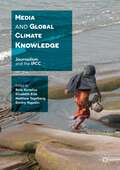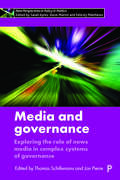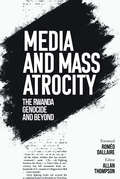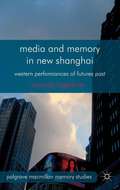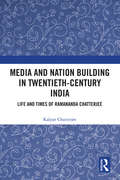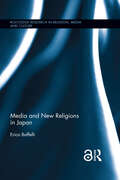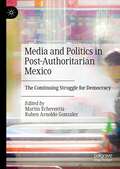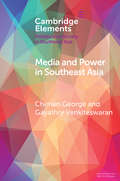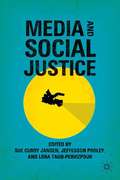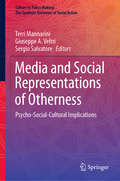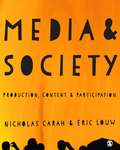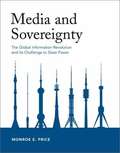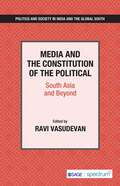- Table View
- List View
Media Strategy and Military Operations in the 21st Century: Mediatizing the Israel Defence Forces (Contemporary Security Studies)
by Michal ShavitThis book applies the concept of mediatization to the contemporary dynamic between war, media and society, with a focus on the Israel Defence Forces (IDF). Since the beginning of the 21st century the IDF has undergone an intensive process of mediatization that has transformed the media into an interpretative grid for many of its military activities and increasingly utilized media to garner public support and construct civilian perceptions of conflict and security through media activity and strategy. This process can be divided into four distinct chronological phases in accordance with the operational challenges confronted by the IDF during this period, from the Al-Aqsa Intifada of 2000, through Israeli unilateral disengagement from Gaza in 2005, and the second Lebanon war of 2006, to the series of Gaza confrontations of 2008-2014. The work shows how the IDF’s media policy evolved from a narrow perception of its role, and separation between operational and media actions to a cohesive and coherently articulated media strategy that is increasingly intertwined with military action and operational strategy and a vital component of strategic military aims and objectives. This strategic stance has led the IDF to adopt a global media perspective using the most advanced new media platforms, designed to influence public opinion and improve national narratives, both in Israel and the international community. By applying the concept of mediatization to the Israeli case, this book fills a research lacuna and offers a new prism for the study of media-military relations in contemporary conflicts. The book will be of much interest to students of civil-military relations, strategic studies, Middle Eastern Studies, media and communication studies, sociology and IR, in general.
Media Talk and Political Elections in Europe and America
by Mats Ekstr�m Andrew TolsonThis book makes an important contribution to the study of political communication. Its chapters provide a detailed analysis of forms of media talk associated with contemporary political elections. The approach is derived from the study of broadcast media talk, which extends here to political communication on the Internet. Key topics include: changing forms of political interview, televised political debates (held in the UK for the first time in 2010), the use of multimedia in promotional discourse, and uses of the Internet to engage with voters (an approach used successfully in the Obama presidential campaigns of 2008 and 2012). In addition to chapters from the UK and USA, there are also contributions from Greece, Spain, Sweden and Austria. Accordingly this book breaks new ground, not only in its coverage of the way politics is communicated to citizens, but also its recognition that in the modern world political culture is increasingly globalised, requiring an international critical perspective.
Media Technology and Cultures of Memory: Mapping Indian Narratives
by Elwin Susan John Amal P. MathewsMedia Technology and Cultures of Memory studies narrative memories in India through oral, chirographic and digital cultures. It examines oral cultures of memory culled from diverse geographical and cultural landscapes of India and throws light on multiple aspects of remembering and registering the varied cultural tapestry of the country. The book also explores themes such as oral culture and memory markers; memory and its paratextual services; embodied memory practices in the cultural traditions; between myths and monuments; literary and lived experiences; print culture and memory markers; marginalized memories in hagiographies; displaying memories online; childhood trauma, memory and flashbacks; and the politics of remembering and forgetting. Rich in case studies from across India, this interdisciplinary book is a must-read for scholars and researchers of cultural studies, sociology, political science, English literature, South Asian studies, social anthropology, social history, and post-colonial studies.
Media and Climate Change: Making Sense of Press Narratives
by Deepti GanapathyThis book looks at the media’s coverage of climate change and investigates its role in representing the complex realities of climate uncertainties and its effects on communities and the environment. The book explores the socio-economic and cultural understanding of climate issues, the influence of environment communication via the news and the public response to it. It also examines the position of the media as facilitator between scientists, policy makers and the public. Drawing extensively from case studies, personal interviews, comparative analysis of international climate coverage, and a close reading of newspaper reports and archives, the author studies the pattern and frequency of climate coverage in the Indian media and their outcomes. With a special focus on the Western Ghats, the book also discusses political rhetoric, policy parameters and events which trigger a debate about development over biodiversity crisis and environmental risks in India. This book will be of great interest to scholars and researchers of environmental studies, especially climate change, media studies, public policy and South Asian studies as well as a conscientious citizen who deeply cares for the environment.
Media and Conflict: Critical Analysis of News Discourses in India
by Francis P. Barclay Kaifia Ancer Laskar Boobalakrishnan NatrayanThis book integrates critical studies of conflict news discourses and social media exchanges in India to discuss their underlying sociopolitical and economic ideologies and powerplays. Using several theoretical frameworks to investigate how assorted Indian conflicts are presented in the mediascape, the book aims to educate and empower audiences—and inspire the next generation of journalists to be constructively critical, ethical and peace-conscious.
Media and Cultural Transformation in China (Media, Culture and Social Change in Asia)
by Haiqing YuThis book examines the role played by the media in China’s cultural transformation in the early years of the 21st century. In contrast to the traditional view that sees the Chinese media as nothing more than a tool of communist propaganda, it demonstrates that the media is integral to China’s changing culture in the age of globalization, whilst also being part and parcel of the State and its project of re-imagining national identity that is essential to the post-socialist reform agenda. It describes how the Party-state can effectively use media events to pull social, cultural and political resources and forces together in the name of national rejuvenation. However, it also illustrates how non-state actors can also use reporting of media events to dispute official narratives and advance their own interests and perspectives. It discusses the implications of this interplay between state and non-state actors in the Chinese media for conceptions of identity, citizenship and ethics, identifying the areas of mutual accommodation and appropriation, as well as those of conflict and contestation. It explores these themes with detailed analysis of four important ‘media spectacles’: the media events surrounding the new millennium celebrations; the news reporting of SARS; the media stories about AIDS and SARS; and the media campaign war between the Chinese state and the Falun Gong movement.
Media and Democracy in Africa
by Michael LeslieRecent discussion of democratization in Africa has focused primarily on the reform of formal state institutions: the public service, the judiciary, and the legislature. Similarly, both scholars and activists have shown interest in how associational life-and with it a civil society-might be enhanced in the countries of the African continent. Much less concern, however, has been directed to the communications media, although they form a vital part of this process. Media and Democracy in Africa provides the first comprehensive and up-to-date assessment of the role of the media in political change in sub-Saharan Africa. The central argument of the volume is that while the media may still be relatively weak compared to their positions in liberal democracies, they have come to play a much more important role than ever before since independence. Although they have not yet demonstrated sufficient effectiveness as public watchdogs and agenda setters, they have succeeded in creating new communicative spaces for people who have previously been intimidated or silent. Building on this the contributors argue that a different conceptualization of democratization than the mainstream currently uses may be necessary to capture the process in Africa where it is characterized by contestation rather than consolidation. This volume shows that the media scene in Africa is diverse. It stretches from the well-developed and technologically advanced situation in South Africa to the still fledgling media operations that are typical in sub-Saharan Africa. In these countries, print media as well as television and radio are just beginning to take their place in society and do so using simple and often outdated technology. The volume also examines how these growing outlets are supplemented by informal media, the so-called radio trottoir, or rumor mill whereby the autocratic and bureaucratic direction of public affairs are subject to private speculation and analysis. Media and Democracy in Africa is organized to provide a historical perspective on the evolution of the African media, placing the present in the context of the past, including both colonial and post-colonial experiences. It will be of interest to Africa area specialists, students of media and communications, political scientists and sociologists.
Media and Democracy in the Middle East (Routledge Studies in Media, Communication, and Politics)
by Nael Jebril Mohammed-Ali AbunajelaThis edited volume examines the current challenges to media freedom and democratisation in the Middle East. The book revisits the relationship between media consumption and activism in the region, providing thorough analyses on the appropriation of social media for political engagement. Since the outburst and spread of what was known as the ‘Arab Uprisings’ in 2010, the political and media landscapes in the Middle East region have dramatically changed. The initial hope for democratic change and governance quality improvements has faded, as several regimes in the Middle East have strengthened their repressive tactics toward voices deemed critical of governments’ practices, including journalists, bloggers, and activists. The crumbling Arab media scene has also reached an abysmal low, with little to no independence, and public perception of basic freedoms in the region has significantly dropped, as has trust in media and government institutions. This book examines current challenges to media freedom, political participation, and democratisation in the region while reassessing the dynamic relationship between media use and political engagement, amidst a complex political environment accompanied by a rapidly changing digital media landscape. This book’s relevance will appeal to varied audiences, such as scholars and students of journalism, communication, political science, and Middle Eastern studies. It will also prove to be an invaluable resource for organisations dedicated to the research of political communication, media freedom, and use patterns of nontraditional, or new, media.
Media and Disaster Risk Reduction: Advances, Challenges and Potentials (Disaster Risk Reduction)
by Rajib Shaw Suvendrini Kakuchi Miki YamajiThis book analyzes recent advances, trends, challenges and potentials of the role of media in disaster risk reduction. Collaboration, co-design and co-delivery with other stakeholders in science technology, private sectors, and civil society are found to be effective in reaching people and communities.The media is considered to be of utmost importance in all phases of disasters, before, during and after, with different types of media having different proactive roles to play in disaster risk reduction. Before disasters, they play essential roles not only in bringing early warning to people but also in enhancing their perception of the need to take action. At during- and post-disaster response recovery phases, community radio and social media are the key. These necessitate a resilient media infrastructure as the core of uninterrupted coverage. Media literacy has become an important issue for several stakeholders, including governments. In addition, more focus is placed on media governance to look at the priorities of disaster risk reduction initiatives within the media. All of these are considered to lead to trust in the media, which further improves people’s disaster response actions based on information from the media, before and during disasters. Covering different aspects of media, this book is a valuable source for students, researchers, academics, policy-makers and development practitioners.
Media and Feminist Protest in Iran: My Camera Is My Weapon
by Layla MayThis book provides an analysis of social media and women’s resistance in Iran with relevance to similar polities. The author examines how Iranian women continue to fight against the regime’s gender discriminatory laws and protest the government in public squares and in virtual spaces. The book presents a critical approach to technology’s role in politics and society and an in-depth analysis of authoritarianism and its relationship to social media harms and state violence. With a particular focus on images, hashtags, and other digital content, it calls for a rethinking of the concepts of crime, culture, and control in the technosocial world. The author draws on conceptual contributions from the fields of criminology, philosophy, psychology, technology and media studies.
Media and Global Civil Society
by Lina DencikA timely and critical investigation into the way media operates in a so-called global age, presenting new empirical data on key sites of news production and crucially tying these findings to ongoing debates on globalization and democracy.
Media and Global Climate Knowledge: Journalism and the IPCC
by Risto Kunelius Elisabeth Eide Matthew Tegelberg Dmitry YagodinThis book is a broad and detailed case study of how journalists in more than 20 countries worldwide covered the Intergovernmental Panel on Climate Change (IPCC) Fifth Assessment (AR5) reports on the state of scientific knowledge relevant to climate change. Journalism, it demonstrates, is a key element in the transnational communication infrastructure of climate politics. It examines variations of coverage in different countries and locations all over the world. It looks at how IPCC scientists review the role of media, reflects on how media relate to decision-making structures and cultures, analyzes how key journalists reflect on the challenges of covering climate change, and shows how the message of IPCC was distributed in the global networks of social media.
Media and Governance: Exploring the Role of News Media in Complex Systems of Governance (New Perspectives in Policy and Politics)
by Thomas Schillemans and Jon PierreFirst published as a special issue of Policy & Politics, this updated volume explores the intersections between governance and media in western democracies, which have undergone profound recent changes. Many governmental powers have been shifted toward a host of network parties such as NGOs, state enterprises, international organizations, autonomous agencies, and local governments. Governments have developed complex networks for service delivery and they have a strategic interest in the news media as an arena where their interests can be served and threatened. How do the media relate to and report on complex systems of government? How do the various governance actors respond to the media and what are the effects on their policies? This book considers the impact of media-related factors on governance, policy, public accountability and the attribution of blame for failures.
Media and Mass Atrocity: The Rwanda Genocide and Beyond
by Allan Thompson Roméo RoméoWhen human beings are at their worst – as they most certainly were in Rwanda during the 1994 genocide – the world needs the institutions of journalism and the media to be at their best. Sadly, in Rwanda, the media fell short. Media and Mass Atrocity revisits the case of Rwanda, but also examines how the nexus between media and mass atrocity has been shaped by the dramatic rise of social media. It has been twenty-five years since Rwanda slid into the abyss. The killings happened in broad daylight, but many of us turned away. A quarter century later, there is still much to learn about the relationship between the media and genocide, an issue laid bare by the Rwanda tragedy. Media and Mass Atrocity revisits the debate over the role of traditional news media in Rwanda, where, confronted by the horrors taking place, international news media, for the most part, turned away, and at times muddled the story when they did pay attention. Hate-media outlets in Rwanda played a role in laying the groundwork for genocide, and then actively encouraged the extermination campaign. The news media not only failed to fully grasp and communicate the genocide, but mostly overlooked the war crimes committed during the genocide and in its aftermath by the Rwandan Patriotic Front. The global media landscape has been transformed since Rwanda. We are now saturated with social media, generated as often as not by non-journalists. Mobile phones are everywhere. And in many quarters, the traditional news media business model continues to recede. Against that backdrop, it is more important than ever to examine the nexus between media and mass atrocity. The book includes an extensive section on the echoes of Rwanda, which looks at the cases of Darfur, the Central African Republic, Myanmar, and South Sudan, while the impact of social media as a new actor is examined through chapters on social media use by the Islamic State and in Syria and in other contexts across the developing world. It also looks at the aftermath of the genocide: the shifting narrative of the genocide itself, the evolving debate over the role and impact of hate media in Rwanda, the challenge of digitizing archival records of the genocide, and the fostering of free and independent media in atrocity's wake. The volume also probes how journalists themselves confront mass atrocity and examines the preventive function of media through the use of advanced digital technology as well as radio programming in the Lake Chad Basin and the Democratic Republic of Congo. Media and Mass Atrocity questions what the lessons of Rwanda mean now, in an age of communications so dramatically influenced by social media and the relative decline of traditional news media.
Media and Memory in New Shanghai
by Amanda LagerkvistContributing to current debates about the globality and mediatisation of memories, Media and Memory in New Shanghai interrogates the city's spectacular regeneration into an emergent world centre, describing how Western elites partake in the production of New Shanghai by feeling its futures and performing its futures past.
Media and Nation Building in Twentieth-Century India: Life and Times of Ramananda Chatterjee
by Kalyan ChatterjeeThis book profiles twentieth-century India through the life and times of Ramananda Chatterjee – journalist, influencer, nationalist. Through a reconstruction of his history, the book highlights the oft-forgotten role of media in the making of the idea of India. It shows how early twentieth-century colonial India was a curious melee of ideas and people – a time of rising nationalism, as well as an influx of Western ideas; of unprecedented violence and compelling non-violence; of press censorship and defiant journalism. It shows how Ramananda Chatterjee navigated this world and went beyond the traditional definition of the nation as an entity with fixed boundaries to anticipate Benedict Anderson and Ernest Gellner. The volume also examines the wide reach and scope of his journals in English, Hindi and Bengali, which published the likes of Rabindranath Tagore, Subhash Bose, Abanindranath Tagore, Nandalal Bose, Ananda Coomaraswamy, the scientist J. C. Bose and Zhu Deh, the co-founder of the Chinese Red Army. He also published India in Bondage by the American Unitarian minister J. T. Sunderland, which resulted in his arrest. An intriguing behind-the-scenes look of early twentieth-century colonial India, this book will be of great interest to scholars and researchers of history, modern South Asia and media and cultural studies.
Media and New Religions in Japan (Routledge Research in Religion, Media and Culture)
by Erica BaffelliThe Open Access version of this book, available at www.taylorfrancis.com/books/9781135117849, has been made available under a Creative Commons Attribution-Non Commercial-No Derivative 4.0 license. Japanese "new religions" (shinshūkyō) have used various media forms for training, communicating with members, presenting their messages, reinforcing or protecting the image of the leader, and, potentially, attracting converts. In this book the complex and dual relationship between media and new religions is investigated by looking at the tensions groups face between the need for visibility and the risks of facing attacks and criticism through media. Indeed media and new technologies have been extensively used by religious groups not only to spread their messages and to try to reach a wider audience, but also to promote themselves as a highly modern and up-to-date form of religion appropriate for a modern technological age. In 1980s and early 1990s some movements, such as Agonshū , Kōfuku no Kagaku, and Aum Shinrikyō came into prominence especially via the use of media (initially publications, but also ritual broadcasts, advertising campaigns, and public media events). This created new modes of ritual engagement and new ways of interactions between leaders and members. The aim of this book is to develop and illustrate particular key issues in the wider new religions and media nexus by using specific movements as examples. In particular, the analysis of the interaction between media and new religions will focus primarily on three case studies predominantly during the first period of development of the groups.
Media and Politics in Post-Authoritarian Mexico: The Continuing Struggle for Democracy
by Martin Echeverria Ruben Arnoldo GonzalezThis volume presents an analytical and empirical overview of the array of issues that the Mexican media faces in the post-authoritarian age, which jointly explains how a partially accomplished democracy, its authoritarian inertias, and its unintended consequences hinder the democratic performance of the media. This is analyzed from three points of view: the stalemate Mexican media system and ineffective regulations, the conditions of risk and insecurity of the journalists on the field, and the limits of freedom of expression, political substance, and inclusiveness of media content. A binational effort, with research from US and Mexican authors, a wide analytic perspective is provided on the macro, meso, and micro levels, allowing for a deep conceptual richness and a comprehensive understanding of the Mexican case. With leading researchers in the field, the volume revolves around the problems of the media in post-authoritarian democracies. By answering the questions of how and why the Mexican media has not fully democratized, the works encompassed here can resonate with and are relevant to other post-authoritarian countries and academic disciplines.
Media and Power in Southeast Asia (Elements in Politics and Society in Southeast Asia)
by Cherian George Gayathry VenkiteswaranThis study of Southeast Asian media and politics explores issues of global relevance pertaining to journalism's relationship with political power. It argues that the development of free, independent, and plural media has been complicated by trends towards commercialisation, digital platforms, and identity-based politics. These forces interact with state power in complex ways, opening up political space and pluralising discourse, but without necessarily producing structural change. The Element has sections on the democratic transitions of Indonesia, Myanmar and Malaysia; authoritarian resilience in Singapore; media ownership patterns in non-communist Southeast Asia; intolerance in Indonesia and Myanmar; and digital disruptions in Vietnam and Malaysia.
Media and Social Justice
by Sue Curry JansenThis book is an anthology of work by critical media scholars, media makers, and activists who are committed to advancing social justice. Topics addressed include but are not limited to international media activist projects such as the Right to Communication movement and its corollaries; the importance of listening and enacting policies that advance democratic media; regional and local media justice projects; explorations of the challenges the era of participatory media pose to public media; youth and minority media projects and activism; ethical dilemmas posed by attempts to democratize access to media tools; the continued marginalization of feminist perspectives in international policy venues; software freedom and intellectual property rights; video activism in both historical and contemporary contexts; internet strategies for defending dissenting voices; and five accounts by prominent scholar/activists of their lifelong struggles for media justice.
Media and Social Representations of Otherness: Psycho-Social-Cultural Implications (Culture in Policy Making: The Symbolic Universes of Social Action)
by Giuseppe A. Veltri Sergio Salvatore Terri MannariniThis book presents the main findings of an empirical exploration of media discourses on social representations of “otherness” in seven European countries. It focuses on the analysis of press discourses produced over a fifteen-year period (2000–2015) on three contemporary figures of otherness that challenge the identity of European societies, question the attitudes towards diversity, and pose significant challenges for policy-makers: immigration, Islam, and LGBT. The book provides a comprehensive and articulate map of how national media addresses such themes from both synchronic and diachronic perspectives, revealing patterns of continuity and discontinuity across time and space. Lastly, it discusses these patterns in the light of their cultural meanings and their influence on social and political collective behaviours.
Media and Society: Production, Content and Participation
by Nicholas Carah Eric Louw'This is the media and society text that critical scholars have been waiting for'. - Professor Mark Andrejevic, Pomona College This book unpacks the role of the media in social, cultural and political contexts and encourages you to reflect on the power relationships that are formed as a result. Structured around the three cornerstones of media studies; production, content and participation, this is an ideal introduction to your studies in media, culture and society. The book: Evaluates recent developments in media production, industries and platforms brought about the emergence of interactive media technologies. Examines the shifting relationship between media production and consumption instigated by the rise of social and mobile media, recasting consumption as ‘participation’. Explores the construction of texts and meanings via media representations, consumer culture and popular culture, as well as the relationship between politics and public relations. Assesses the debates around the creative and cultural labour involved in meaning-making. Includes a companion website featuring exercise and discussion questions, links to relevant blogs and web material, lists of further reading and free access to key journal articles.
Media and Society: Production, Content and Participation
by Nicholas Carah Eric LouwThis book unpacks the role of the media in social, cultural and political contexts and encourages you to reflect on the power relationships that are formed as a result. Structured around the three cornerstones of media studies; production, content and participation, this is an ideal introduction to your studies in media, culture and society. The book: Evaluates recent developments in media production, industries and platforms brought about the emergence of interactive media technologies. Examines the shifting relationship between media production and consumption instigated by the rise of social and mobile media, recasting consumption as 'participation'. Explores the construction of texts and meanings via media representations, consumer culture and popular culture, as well as the relationship between politics and public relations. Assesses the debates around the creative and cultural labour involved in meaning-making. Includes a companion website featuring exercise and discussion questions, links to relevant blogs and web material, lists of further reading and free access to key journal articles.
Media and Sovereignty: The Global Information Revolution and Its Challenge to State Power
by Monroe E. PriceHonorable Mention for the 2002 Communication Policy Research Award presented by The Donald McGannon Communication Research Center. Media have been central to government efforts to reinforce sovereignty and define national identity, but globalization is fundamentally altering media practices, institutions, and content. More than the activities of large conglomerates, globalization entails competition among states as well as private entities to dominate the world's consciousness. Changes in formal and informal rules, in addition to technological innovation, affect the growth and survival or decline of governments. In Media and Sovereignty, Monroe Price focuses on emerging foreign policies that govern media in a world where war has information as well as military fronts. Price asks how the state, in the face of institutional and technological change, controls the forms of information reaching its citizens. He also provides a framework for analyzing the techniques used by states to influence populations in other states. Price draws on an international array of examples of regulation of media for political ends, including "self-regulation," media regulation in conflict zones, the control of harmful and illegal content, and the use of foreign aid to alter media in target societies.
Media and the Constitution of the Political: South Asia and Beyond
by Ravi VasudevanThis volume features the writings of leading media scholars from South Asia and Europe on the topic of how media articulates political energies and transformational logics. The research traverses the press, newsreels, entertainment cinema, photography, television, music, social media and data-driven politics. The authors consider how media industries, institutions and practices constitute sites where conflicts relating to wider social change are observable. Authors address media materiality and aesthetics in tracking political effects and resonances on subjects such as wire photo transfers, film set design, the formal structures of the newsreel, the role of television audience surveys, the relationship between digital and paper records, the place of media in courts of law and the phenomenon of the media trial. The overall approach in understanding media and the political is not only to access formal institutions, both of media and politics but also to expand perspective to trace the wider dispersed appearance of the political in and through media.
